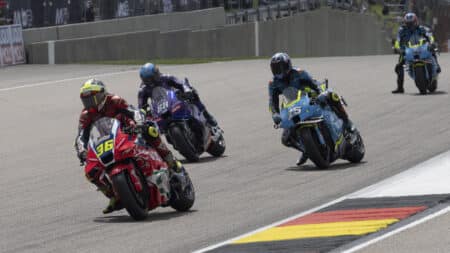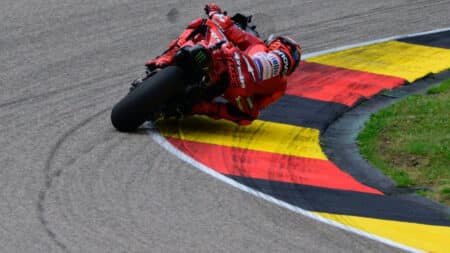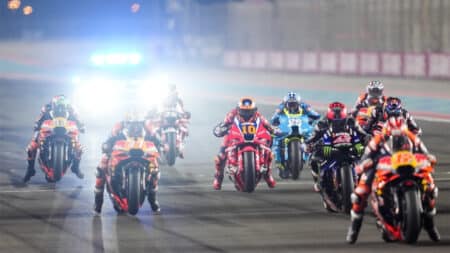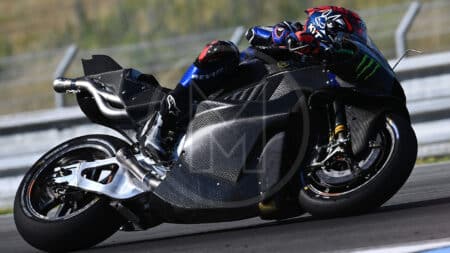Let’s do some maths: nine races gone and nine to go, so it’s halfway time when we get to examine the past with the benefit of 20/20 hindsight and pretend we’ve got even the slightest clue about what’s going to happen next.

If we take Sunday’s German GP and extrapolate that result all the way to Valencia, Marc Márquez will record a famous comeback world-title victory. However, if Márquez, Valentino Rossi and Jorge Lorenzo each win three of the remaining nine races, while recording podium finishes in the other six, then Rossi will most likely make history with a 10th world title, 18 years after his first. The possibilities are endless, of course, though it might be fun if someone fed the data into a supercomputer. Please be my guest…
What the supercomputer would fail to take into account is tyres. But MotoGP runs a control-tyre rule, so all the riders run the same tyres, right?

Not exactly. During the 18-race season Bridgestone make a total of 17 different rear tyres available, usually limited to two different types per race. So, not much room for personal advantage or disadvantage? In fact, even within this narrow allocation there is room for Rossi or Márquez to find more speed than Lorenzo with one tyre, and vice versa.
It all goes back to October 2013 when Bridgestone presided over the chaotic Australian GP, where an aggressive new track surface cooked tyres into bubblegum. Eventually the race was shortened by a third with a compulsory mid-race tyre stop because Bridgestone couldn’t guarantee its rear tyres would last more than 25 miles.
Understandably Bridgestone bosses were apoplectic, their faces the colour of the company’s scarlet logo. So during the winter of 2013-14 its engineers wrapped a heat-resistant band around the carcass to ensure such a calamity would never befall them again.
All was well until riders convened for the first 2014 tests at Sepang to try these new tyres. The stiffer-construction slicks were indeed indestructible, but they lacked edge grip at maximum lean. Most riders complained, but none more so than Jorge Lorenzo, whose devastating corner speed relies entirely upon swooping through the apex riding the edge of the rubber for all its worth. Without that he was going nowhere.

Bridgestone listened to the 2010/2012 champ and to his rivals, then went home to Japan and modified its tyres with a special treatment that fixed the edge. The treatment is top secret, but it probably has something to do with how it layers the rubber.
Lorenzo was delighted, until he got to the few tracks where high tyre temperatures were such a concern that Bridgestone didn’t dare treat the edge of its tyres.
There are currently four tracks which require such rubber – Mugello, Assen, Sachsenring and Phillip Island – where circuit layout and asphalt character are too much for the edge treatment.

This explains why Lorenzo moaned like hell at Assen, where he finished a distant fourth, and again at the Sachsenring where he came home in the same place, because the tyres didn’t give him that friendly, compliant mid-corner feeling.
“My style couldn’t take profit of the tyre,” he said on Sunday. “Whereas Valentino has a different style with the throttle, so he can cope better, especially when the tyre drops.”

In other words, Rossi, like Márquez, spends less time on the edge of the tyre, focusing instead of getting in and out of the corner, rather than taking wide cornering arcs. Lorenzo, meanwhile, needs technical perfection from bike and tyre, or he cannot work his magic.
At least Lorenzo understands how MotoGP’s tyre pendulum works, so he knows that next time or the time after that he should be able to disappear over the horizon like he did at four races earlier in the year. “I’ve had two bad races, so it’s just a matter of time before we go to tracks where the tyres are good for me, so I can recover some points on Valentino and Marc.”
Although all Bridgestone rear slicks feature this heat-resistant carcass, only some tyres in the tyre allocation at each race feature the special edge treatment. So a softer tyre within the allocation won’t use the treatment, while a harder tyre does, to make it more rideable on the very edge.
So it all depends on who chooses what and where. If Lorenzo needs the tyre life of a rear slick that doesn’t feature the edge treatment he will be in trouble. Meanwhile Rossi and Márquez, who muscle their machines and jump on the throttle, rather than tight-roping their way through corners, should have the advantage. And vice versa.

But before you start concocting conspiracy theories, do please remember that in the murky, ambiguous world of bike racing there’s always something that doesn’t neatly fit the story. At Mugello Lorenzo won without the edge-treatment tech. Even Bridgestone aren’t sure how that worked. Perhaps the track temperature was high enough to give him the feel he needed on the very limit, or perhaps it was a case of mind over matter, that hugely important and always unquantifiable factor in motorcycle racing.
Or maybe Lorenzo’s team found a little trick with the electronics that removed the fear factor at maximum lean. Or maybe it was more mechanical than that. Teams can vary tyre performance in all manner of ways, by changing load through adjusting geometry, suspension and so on.
Lorenzo’s team-mate Rossi has been revitalised since race day at the Catalan Grand Prix by a tiny 6.35mm change to his motorcycle. After struggling to match Lorenzo at Jerez, Le Mans and Mugello, and then again during Catalunya practice, his crew switched from a 4in front wheel rim to a 3.75in front rim.
This change pulls the bead of tyre tighter into the centre of the rim, which creates a sharper profile. The downside is a slightly reduced contact patch. The upside is a quicker steering. And that’s exactly what Rossi needed to help him attack corners more effectively.
“It’s like the bike is lighter, with better agility,” said the nine-time champion after chasing down Lorenzo at Catalunya and beating everyone at Assen.

Honda seemed back to its dominant best at the Sachsenring, with the kind of 1-2 that could make Márquez champion again. But it shouldn’t be forgotten that the RCV has won the last six races at the ‘Ring: three each to Márquez and Dani Pedrosa. So success at the ‘Ring doesn’t necessarily mean four more months of domination.
All that matters now is which Bridgestones are going to work best for Rossi, Lorenzo and Márquez at Indy, Brno, Silverstone, Misano, Aragon, Motegi, Phillip Island, Sepang and Valencia. You can be sure that the most anxious moments these three men will share during the next few months are when they see the tyre allocation sheets for the next race.
Last year Honda won five of the last nine races (Indy, Brno, Silverstone, Sepang and Valencia) while Yamaha won four (Misano, Aragon, Motegi and Phillip Island). Márquez won four, Lorenzo and Rossi two each and Dani Pedrosa one. But don’t assume you can divine the outcome of the next few races from last year’s results, because Bridgestone’s 2015 tyre specs are different from last year’s, so what worked for someone last summer won’t necessarily work this time around.
Tyres may be black and round (as proud technophobe Mike Hailwood once opined), but they may yet decide the outcome of the 2015 MotoGP world title.












